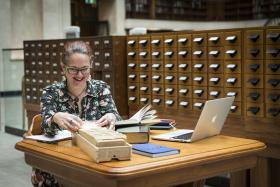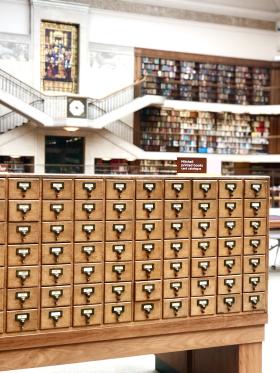History on the cards
Please be aware that this article discusses historical events that are painful to Aboriginal and Torres Strait Islander people.
Some 30 years into her relationship with the Library, professional historian Dr Naomi Parry is still finding unexpected surprises in the collection.

Naomi began using the Mitchell Library and was immediately enchanted. ‘There’s nothing as grand as the Mitchell Reading Room in Tasmania and I just thought it was the most amazing space to be in’, she recalls. ‘I would walk in and Gough Whitlam would be sitting there.’ She discovered the card catalogues and began to recognise the many pathways they create through such a vast and idiosyncratic collection. ‘It’s so important that the card catalogues are never removed from public access, because they are an archive in and of themselves — the way they have been indexed, the notes and annotations on them. They are so precious.’ Naomi delights in the fact that she has spent most of her career learning to use them better.
Not long after her first encounter with the Library, Naomi began an Honours thesis on the placement of Aboriginal girls into domestic service. She sought the expertise of Indigenous Engagement Librarians Melissa Jackson and Ronald Briggs and broadened her research into a PhD, which examined the differences between black and white child welfare in New South Wales and Tasmania.
‘For me, an essential part of visiting the Mitchell Library is being able to work with the expert staff to help you make connections within the collections. They can whiz through the catalogues in ways that I can’t. It takes a lot of knowledge and expertise.’ In 2016, Naomi co-wrote the NSW Centenary of Anzac publication New South Wales and the Great War, working with State Library Senior Curator Elise Edmonds to match over 400 images from the collection with the stories she was writing.
Throughout her extensive and varied career, there is one particular project that has kept Naomi returning to the archives.
Almost 20 years ago, then-editor of the Australian Dictionary of Biography Chris Cunneen asked Naomi to write a biography of Musquito, a Gai-mariagal resistance leader. Musquito was exiled to Norfolk Island in 1805, before being evacuated eight years later to Van Diemen’s Land where he was used as a tracker. Promises by the Governor to return him to his home in Sydney never eventuated. Disappointment drove Musquito into the bush, where he joined the ‘tame gang’ and subsequently the Parerdarerme (Oyster Bay) people, who were involved in a number of raids on the east coast. Musquito and companion Black Jack were tried for murder, in the very first trial of the Hobart Supreme Court and hanged in February 1825.
Musquito’s story has preoccupied Naomi ever since. She’s received support from the Library’s National and State Libraries Australasia Fellowship, the Australia Institute, the Australia Council and the Copyright Agency but having set 2020 aside to write, found her progress frustrated by pandemic restrictions. Now she has added a new challenge to her project by taking up a position as Lecturer in Humanities at the College of Arts, Law and Education at the University of Tasmania. ‘I have a research component to my job, so my book is filling that … over filling that,’ she laughs.
Naomi is acutely aware of the complexities of writing about an Indigenous man as a non-Indigenous scholar. ‘It’s always been a difficult space; I’ve had to do a lot of thinking about where I stand. One of the things I discovered in the Mitchell and Dixson collections was the extent to which the many narratives about Musquito were shaped by where people sat politically. I feel there’s a responsibility amongst scholars to address the misrepresentations of Aboriginal people by white people, and to do that in a context of conversation with Aboriginal people. For me, working closely with the Library’s Aboriginal librarians and curators is an essential part of that but it’s also about working with communities.’ The last year has sharpened her focus, ‘the narratives of inevitability about the dispossession of the Palawa have been activated again in relation to climate and fires, and our vulnerabilities during the pandemic — but history shouldn’t be written to take away the responsibility of human intervention’.

A long career spent working in museum and archival collections has matured the wide-eyed excitement of that first encounter with the Mitchell Library. But in the past few weeks, Naomi has once again experienced the kind of ‘eureka moment’ that researchers live for. Alongside Melissa, within the card catalogues, she has learned of a holding which illuminates her book on Musquito. She had no idea it was in the collection, despite decades of research.
She can’t talk about it yet. She needs to sit in the Library space, bottle the feelings and work out how to communicate what she has found. ‘The collection links you with these incredible experiences that give you a profound sense of proximity to people in the past. You can go wherever you want in a way, and I love that. And anyone can.’
Mathilde de Hauteclocque
Library Assistant, Information & Access
![Misquito [i.e. Musquito] and Devil's Hole Tasmania, 1868 / J. R.](/sites/default/files/styles/max_width_280/public/c15556_0001_c.jpg?itok=CSwpuo67)